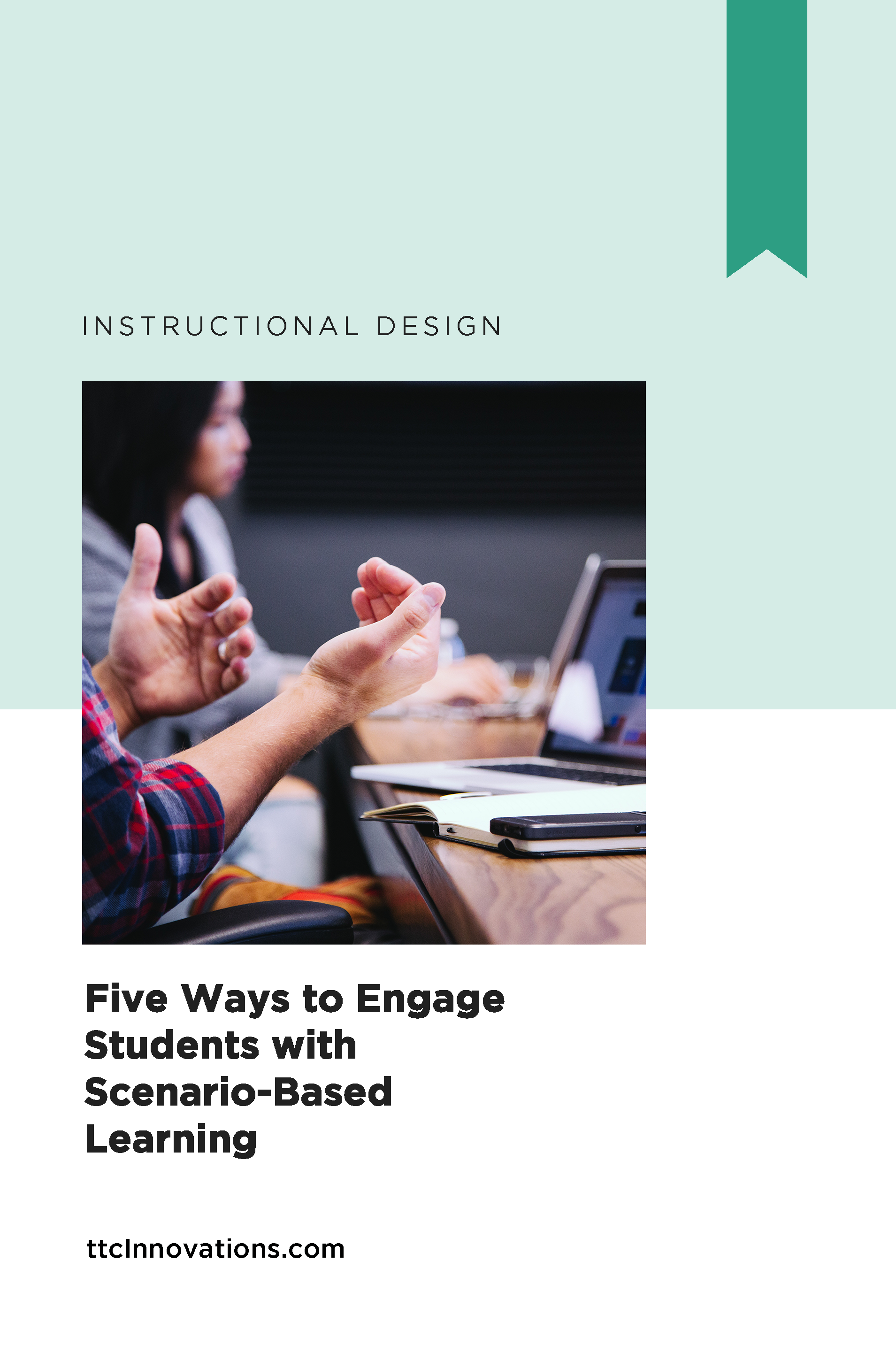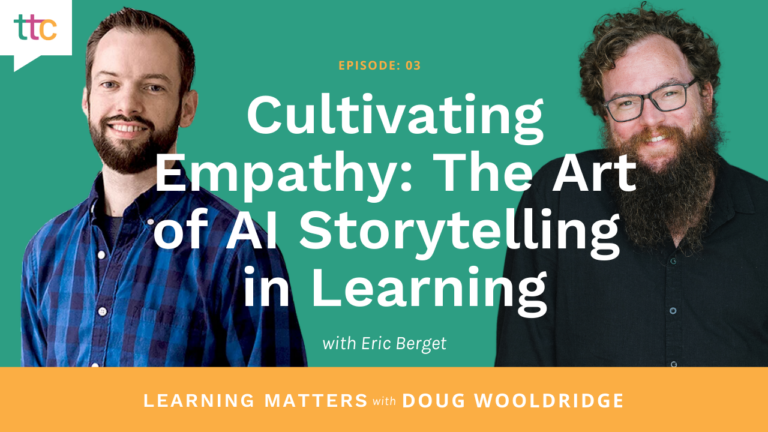In scenario-based learning, learners work through challenges or exercises presented along a specific story line. Good scenario-based training is aligned with the job performance expectations for the learner once they complete the course.
Why Scenario-Based Learning is Effective
Effective learning scenarios mimic the tasks associated with a given job. Thus, learners bring a set of skills they already possess to the training, and because the scenario is presented in a recognizable context — learners can access what they already know. This is called retrieval. According to Marlieke van Kesteren, a postdoctoral researcher in educational neuroscience at VU Amsterdam,
“This act of retrieving knowledge has been shown to be very beneficial to learning, strengthening both the stored and the newly learned knowledge.”
Because these scenarios mimic real life, learners have to apply the knowledge they acquire as they learn it. This promotes both retention and transfer of information and skills to the real-world context. In her book, “A Manager’s Guide to Unleashing the Intrapreneur” Debbie Wooldridge, CEO of ttcInnovations, underscores the importance of relevance for today’s learners—
“The ability to apply recently acquired knowledge instantly is important to Millennials. In an era where you can quickly go to YouTube® to view a video on how to do just about anything, Millennials need the same approach to learning content. Build practice activities and meaningful performance-based assessments into your training content. This gives Millennials the instant context and feedback they crave.”

FREE Download!
Download the first chapter of “A Manager’s Guide to Unleashing the Intrapreneur” here and begin to unleash your own intrapreneur.
One especially important reason why scenarios are so effective is that they allow learners to “fail,” or make mistakes in a safe environment, without the threat of real-world consequences. This makes it possible for learners to take greater risks and learn as much about what happens when they do something incorrectly as they learn when the task is performed correctly.
Finally, this type of instruction evokes emotion and, when delivered well, can be fun for learners. Playfulness opens up learning centers in the brain that help the individual take in information more effectively. It relaxes barriers to knowledge/skill acquisition and leads to more organic learning.
Scenario-Based Instruction Keeps Learners Engaged
Think about the last time you watched a television program. It’s likely you were also eating, maybe talking with family, petting the dog, getting up to close the curtains or turn on lights, etc. When we are passively receiving information, it’s human nature to look for other ways to stay stimulated.
Scenario-based instruction keeps learners engaged because more parts of their brain are actively involved. They must do something to get more information, which means they aren’t just receiving, they are taking an active role in their education. When presented with a situation in which they must solve a problem or choose an action, learners must make decisions. The mental effort necessary to decide what to do and then act upon that decision keeps learners focused on the task rather than allowing their minds to wander.
Finally, scenarios keep learners engaged because the content is relevant to their job and provides a context in which to apply what they learn. Think about it. If someone tells you an interesting piece of gossip about someone you don’t know, how much do you really listen and react to the story? On the other hand, what if you know the person? Relevancy gives us a reason to pay attention.
Five Strategies for Creating Great Scenario-Based Instruction
1. Simulations
ABC Company is replacing their customer service software with a new system. It’s different from what the customer service representatives are used to, so the company is retraining them. Today they are completing a series of simulations on the kinds of activities they typically perform on the job. Right now, everyone is engaged in a role-play activity in which Peter plays a new customer and Sue plays the customer service rep. What makes this role play unique and effective is the use of simulated tasks in the application. So, while Sue interacts with Peter in this role play, she is also actively filling out his order in the simulation.
What makes this a great use of scenario-based instruction is the context. Here, Sue can simultaneously simulate the customer interaction and use of the system — mirroring what she is used to doing with the old application. This lets her practice a real process in an environment that is as close to the real world as possible, while also allowing her to safely make mistakes and learn to correct them before she uses the new application with a real customer.
Takeaways for developers: Be sure to create a strong and relevant context for the simulation that mirrors the way learners will use this knowledge or skill on the job. It’s the pairing of the role play with the simulation that makes this example so effective. In some cases, you may need to string several simulations together to help the learners accomplish a real-world task. In the end, it’s the similarity to the real world that makes this type of training so effective.
2. Branching
Adam is a new hire in an assembly line position. His job will be to assemble six different parts based on a work order and the core unit he receives via the assembly line. In his job, he will have to make decisions about which sub-parts (such as bolts, screws, plates, etc.) to select from the boxes on his bench to assemble the part on the work order. Adam is learning via a web-based training program. To begin this part of the training, he has been given four core units, 16 boxes with sub-parts, and a work order. The work order calls for him to build three different parts. What he sees on the screen mimics what he will eventually see on the assembly line. Adam’s next step is to choose the part he will build first by clicking on a core unit. Adam could choose any of the three core units to build first. No matter which he chooses, the system branches to support his ability to learn all three tasks. And if he selects a core unit that is not on his work order, the system can prompt him to take the effective action for that choice (call a supervisor, for instance).
What makes this a terrific example of scenario-based instruction is that Adam chooses the flow of learning that best matches his needs. Some learners will choose the easiest path first to build confidence, while others like the challenge of tackling the most difficult task first. Branching scenarios can also be used to provide selective content to specific learners. Imagine, for example, that Adam is being trained to build three different types of parts, two of which overlap with another trainee, but the third does not. By initially selecting the applicable job title, Adam and his colleague can self-sort to receive just the training they need.
Takeaways for developers: When you ask learners to select one branch or another, they should know why they are making the choice, and it should mimic choices they will make (which part to start with) or choices already made for them (such as their role) in the real world.
3. “Virtual” Environments
XYZ Bank is opening a new branch in a new country. They have hired all new people for this branch and because of restrictions in the country, some of the procedures the new hires will need to use are not used elsewhere in the bank, so the company has chosen not to train them by shadowing employees at other branches as they normally do. The employees have just completed a six-week new hire training program designed just for them, and the branch is due to open in three days. Today, they are each occupying their real positions in the bank, acting as they will when the branch opens. Volunteers from the company are acting as customers who arrive with various requests. Throughout the next three days, the employees will perform their tasks using real software, play money, and real situations with fake customers. Trainers will walk the floor to assist when a learner gets stuck.
This virtual environment gives learners a chance to test their learning before the branch opens its doors to real customers. Virtual environments mimic as closely as possible the full context of a task, a set of tasks, or the job. Learners can practice making choices and applying their learning on a continuous basis as they will in the real world. Today, virtual environments also include virtual reality applications. These platforms offer a great deal of flexibility for scenario-based learning, but they are more expensive and require greater expertise from IT professionals than most learning organizations have. The simplest environments are usually the actual work environment (as in the example).
Takeaways for developers: Think “mock” environment. Try to mock up as much of the real world as possible: a backlogged inbox, an unexpected customer request, a line of customers waiting on your help, etc. Emulate real life as closely as you can. The more likely your scenario, the more it will keep learners engaged and transfer well to the real world.
4. Gamification
After six months of training and another six months on the job, ABC Bank phone representatives are still having trouble with some common transactions. Now, during breaks in the flow of calls, learners are playing a game that allows them to take simulated calls. Successful completion of the transactions in these simulated calls wins them badges, and accumulating badges lets them “level up” to more difficult transactions.
Gamification enhances the learners’ engagement and emotional quotient during their learning experience. Learners stay motivated because they are having fun and want to win the competition. This style of scenario-based training also promotes recall because the interaction with the game keeps more parts of the brain involved. In addition, games challenge the learners so that by comparison, the real-world transactions seem easier.
Takeaways for developers: Games are a great way to add fun, mystery, action-based engagement, challenges, and risks to the learning. Gamification works best when it uses elements of the job (like the simulated transactions) rather than a game for its own sake (for example, Jeopardy).
Related: 3 Ways to Bring Gamification to Your Training – On a Budget
5. Concept Maps
The leaders at BMX Corporation have completed a week-long learning program designed to enhance their leadership skills. As a final exercise, they are working on building concept maps. Their task: complete a concept map of all the concepts they learned over the course of the training, making sure the connectors both describe the relationships to each other and how they will apply the concepts to the job.
Concept maps are useful when you want the learner to create their own scenario. The image below is a very simple concept map of the content for this blog.
In a training environment, concept maps can be used to add scenario-based relevancy to existing courses. Carnegie Mellon University offers this description of a concept map:
“Concept maps are a graphic representation of students’ knowledge. […] Concept maps include concepts, usually enclosed in circles or boxes, and relationships between concepts, indicated by a connecting line. Words on the line are linking words and specify the relationship between concepts.”
For scenario-based learning, this concept is extended to include the learner. When learners place themselves into the map (note the star to the right) and include connecters to the concepts, a scenario of the job emerges. Note the changes in the map below.
Now the map becomes a scenario or set of scenarios for applying the learning in the learner’s personal unique job context.
Takeaways for developers: There is no right or wrong way to do these. Learners should be encouraged to use shapes that reflect the concept and to be as creative as they choose. Typically, connectors are verbs and concepts are nouns. The connections between concepts can usually be read as sentences. However the concept map is formatted, the most important thing is that it should be meaningful and relevant to the learner who creates it.
Scenario-based learning is an exciting way to keep learners engaged, ensure better knowledge transfer on the job, and enhance retention. When you are planning development for training courses, it’s always a good idea to think about how you can incorporate scenario-based instruction.








